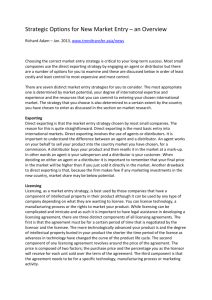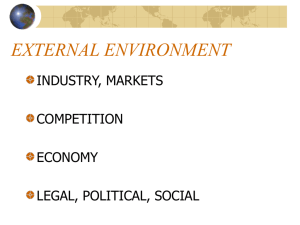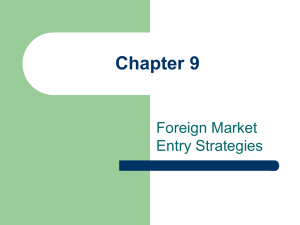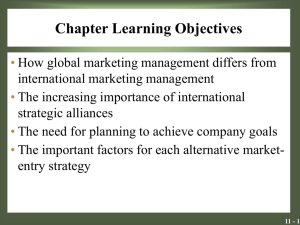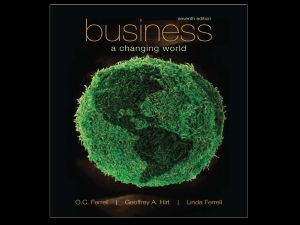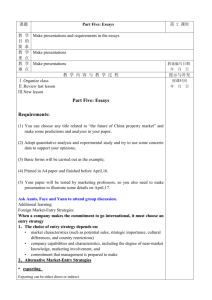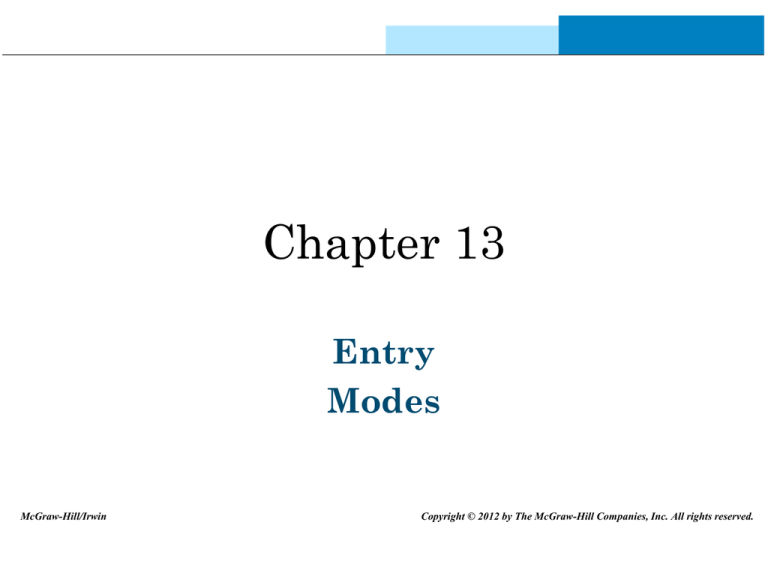
Chapter 13
Entry
Modes
McGraw-Hill/Irwin
Copyright © 2012 by The McGraw-Hill Companies, Inc. All rights reserved.
LO1
Exporting “Pioneer” or “Fast
Follower” Which is Better?
• “Pioneers” succeed in
exporting when
• “Fast Followers” will
succeed when
– Insulated from competitor
entry
– Strong patent protection
proprietary technology
– Big investment
requirements
– Has size, resources and
competencies (R&D,
marketing) to leverage
pioneering position
– Few legal, financial, and
cultural barriers exist
– Sufficient resources and
competencies to
overwhelm pioneer’s early
advantage
– Larger resource base than
Pioneer to reduce unit
costs and offer lower
prices
13-2
LO2
Nonequity Modes of Entry
• Starts with Exporting:
– Selling some regular production overseas
– Requires little investment
– Relatively free of risk
• The next choices:
– Indirect Exporting
– Direct Exporting
• Or:
–
–
–
–
–
Turnkey Projects
Licensing
Franchising
Management Contracts
Contract Manufacturing
13-3
LO2
Nonequity Modes of Entry
• Indirect exporting done through
home-country based exporters
– No special expertise
– No large cash outlay
• Called in the trade as:
– Manufacturers’ Export
Agents
sell for the manufacturer
– Export Commission Agents
buy for overseas
customers
– Export Merchants
• Costs of indirect
exporting:
– Commissions
– Lost foreign business if
exporters change
suppliers
– Exporters gain little
international experience
purchase and sell for own
accounts
– International Firms
Use their own goods abroad
13-4
LO2
Direct Exporting
• Direct Exporting:
– “the exporting of goods and services by a firm that
produces them”
– Initial responsibility done internally – sales
manager
– Sales company may be set up
– Internet makes direct exporting easier
• High level investment for international presence
• Cost of trial is low
13-5
LO2
Turnkey Projects
• Turnkey projects are used to export:
– technology
– management expertise
– capital equipment (some cases)
• Exporter of a turnkey project may be a:
– contractor that specializes in designing and erecting plants in
a particular industry
• After a trial run, the facility is turned over to the purchaser
– company that wishes to earn money from its expertise
– producer of a factory
13-6
LO2
Licensing
• Licensing
– “a contractual arrangement in which one firm (licensor) grants access
to its patents, trade secrets, or technology to another (licensee) for a
fee”
– Licensee pays fixed sum and sales royalties (2%-5%) over life of
contract with renewal option
• Anything can be licensed – technology, brand &
manufacturer names, logos, symbols, colors
• Licensing is attractive because:
– courts have begun upholding patent infringement claims
– patent holders have started suing violators
– foreign governments have begun enforcement of their patent laws
• A Licensee may become a competitor!
13-7
LO3
Piracy
• Patent Infringement
• Intellectual property
protection:
– courts have begun
upholding patent
infringement claims
– patent holders have
started suing violators
– foreign governments have
begun enforcement of
their patent laws
• Traditional Piracy
– Attack on defenseless
sailing vessels, theft of
cargo and/or ship on the
high seas
• Pirates can be:
– International terrorists
– Organized crime
– Poor local fisherman
• Locations:
– Waters around Indonesia,
Nigeria, Somalia,
Bangladesh & Caribbean
13-8
Franchising
LO2
• Franchising:
– “a form of licensing in which one firm contracts
with another to operate a business under an
established name according to specific rules”
• The franchisee gets:
– Publicized brand name
– Well-known set of procedures
– carefully developed & controlled controlled
marketing plan
13-9
LO2
Management Contract
• Management Contract
– “An arrangement by which one firm provides
management in all or specific areas to another firm”
– Typical fee is 2-5% of annual sales and tax
deductable
• MNCs make contracts with:
– Other firms with no ownership interest
– Joint venture partners
– Wholly owned subsidiaries
13-10
LO2
Contract Manufacturing
• Contract Manufacturing
– “An arrangement in which one firm contracts with
another to produce products to its specifications but
assumes responsibility for marketing”
• Other types of:
– Subcontract assembly or parts production
– Lend capital to 3rd party foreign contractor
• Called “foreign direct investment without
investment”
13-11
LO2
Equity-Based Modes of Entry
1. Wholly Owned
Subsidiary
2. Joint Venture
3. Strategic Alliances
• Wholly Owned
Subsidiary
1. Start from the ground up by
building a new plant
(greenfield investment)
2. Acquire a going concern
3. Purchase its distributor to
obtain a distribution
network familiar with its
products
13-12
LO2
Joint Venture
1. Joint Venture
– “A cooperative effort
among two or more
organizations that
share a common
interest in a business
enterprise or
undertaking”
1. A corporate entity formed by
an international company
and local owners;
2. A corporate entity formed by
two international companies
for the purpose of doing
business in a third market;
3. A corporate entity formed by
a government agency
(usually in the country of
investment) and an
international firm; or
4. A cooperative undertaking
between two or more firms
of a limited-duration project.
13-13
LO2
Issues with Venture Ventures
• Strong nationalism
• Expertise, tax & other benefits
• Disadvantages:
– Shared profits
– Minority ownership position
– Difficulty in share distribution to allow minority
owner to be largest stockholder
– Lack of control
– Local law requiring local majority ownership
– Joint venture control through management
contracts
13-14
LO2
Strategic Alliances
• Strategic Alliances
– “partnerships between or
among competitors,
customers, or suppliers that
may take one or more various
forms, both equity and
nonequity”
• Goals of Strategic
Alliances:
– Faster market entry and
start-up
– Access to new products,
technologies, and markets
– Cost-savings by sharing
costs, resources, and risks
• Issues with Strategic
Alliances:
– Alliances may be Joint
Ventures
– Pooling versus Trading
Alliances
– Alliances versus Mergers
and Acquisitions
– Future of Alliances
13-15
LO2
Issues with Strategic Alliances
• Strategic Alliances may be Joint Ventures
– In manufacturing and marketing
• Pooling versus Trading Alliances
– Pooling Alliances – driven by similarity and integration
– Trading Alliances –driven by the logic of contributing dissimilar resources
– Fundamental differences:
• Goals (common vs. compatible)
• Optimal resources (many vs. few partners)
• Managerial challenges (low vs. high coordination needs)
• Alliances versus Mergers and Acquisitions
– Mergers and acquisitions not considered alliances, but ways to access new
technology
• Future of Alliances
– Many fail or are taken over by a partner
– Difficult to manage due to different strategies, operating practices, and
organizational cultures
– Partner may acquire technological or other competencies and become
competitor
13-16
LO4
Reasons to Export
• To serve markets where the firm has no or limited production
facilities.
• To satisfy a host government’s requirements that the local
subsidiary have exports.
• To remain price competitive in the home market.
• To test foreign markets and foreign competition inexpensively.
• To meet actual or prospective customer requests for the firm to
export.
• To offset cyclical sales in the domestic market.
13-17
LO4
Reasons to Export
• To achieve additional sales, which will allow the firm to use
excess production capacity to lower per-unit fixed costs.
• To extend a product’s life cycle by exporting to currently
unserved markets where the product will be at the introduction
stage of the life cycle.
• To respond strategically to foreign competitors that are in the
firm’s home market by entering their home market.
• To achieve the success the firm’s management has seen others
achieve by exporting.
• To improve the efficiency of manufacturing equipment, which
usually works better at or near full capacity.
13-18

